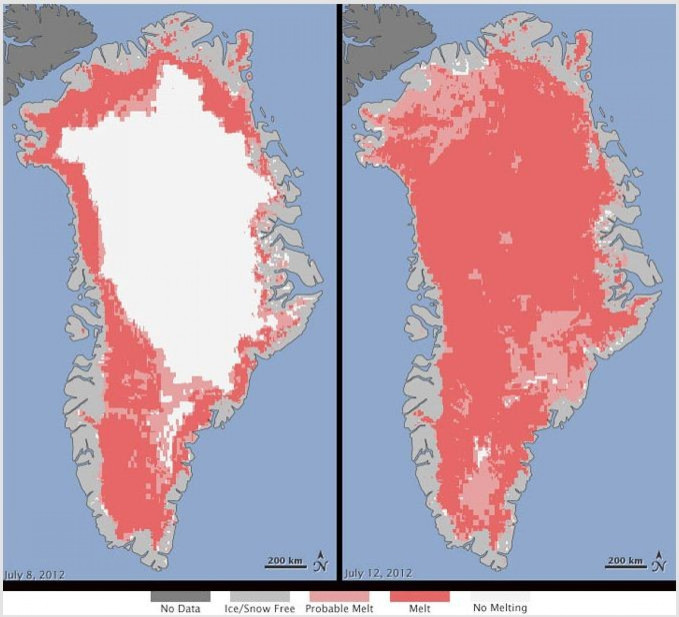NASA Satellites Reveal An Unprecedented 97% Of Greenland Ice Sheet Surface Melt In Mid-July

The latest measurements from three independent satellites analyzed by NASA for several days in July show that Greenland's surface ice cover has melted over an area larger than at any time in more than 30 years of satellite observations.
Scientists said that on average in the summer, about half of Greenland's ice sheet surface melts naturally, while at high elevations, most of the melted water quickly refreezes in place. On the other hand, near the coast, some of the melted water is retained by the ice sheet and the rest is lost to the ocean. But it was not the case this year as the extent of ice melting at or near the surface increased dramatically.
As per satellite data, on July 8, about 40 percent of the ice sheet underwent thawing at or near the surface. But in just a few days, the melting had dramatically accelerated and an estimated 97 percent of the ice sheet surface had melted by July 12.
However, researchers are yet to determine whether this extensive melt event will affect the overall volume of ice loss this summer and contribute to a rise in the sea level.
The Greenland ice sheet is a vast area with a varied history of change. This event, combined with other natural but uncommon phenomena, such as the large calving event last week on Petermann Glacier, are part of a complex story, said Tom Wagner, NASA's cryosphere program manager in Washington. Satellite observations are helping us understand how events like these may relate to one another as well as to the broader climate system.
It was Son Nghiem of NASA's Jet Propulsion Laboratory in Pasadena, Calif., who noticed that most of Greenland appeared to have undergone surface melting on July 12. He came up with the findings while analyzing radar data from the Indian Space Research Organisation's (ISRO) Oceansat-2 satellite last week.
Nghiem said, This was so extraordinary that at first I questioned the result: was this real or was it due to a data error?
Nghiem consulted with Dorothy Hall at NASA's Goddard Space Flight Center in Greenbelt, Md. Hall studied the surface temperature of Greenland using the Moderate-resolution Imaging Spectroradiometer (MODIS) on NASA's Terra and Aqua satellites and confirmed that MODIS showed unusually high temperatures and that the melt was extensive over the ice sheet surface.
Thomas Mote, a climatologist at the University of Georgia, Athens, Ga., and Marco Tedesco at the City University of New York also confirmed the melt seen by Oceansat-2 and MODIS with passive-microwave satellite data from the Special Sensor Microwave Imager/Sounder on a U.S. Air Force meteorological satellite.
This extreme melt event coincided with an unusually strong ridge of warm air, or a heat dome, over Greenland. The ridge was one of a series that has dominated Greenland's weather since the end of May.
Each successive ridge has been stronger than the previous one, said Mote. This latest heat dome started to move over Greenland on July 8 and then parked itself over the ice sheet about three days later. It had begun to dissipate by July 16.
© Copyright IBTimes 2024. All rights reserved.












